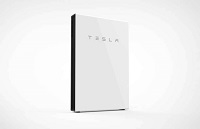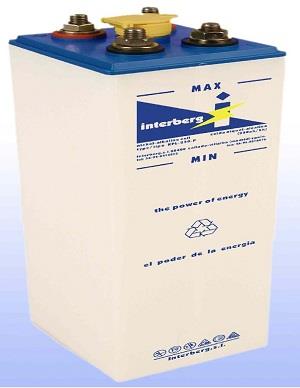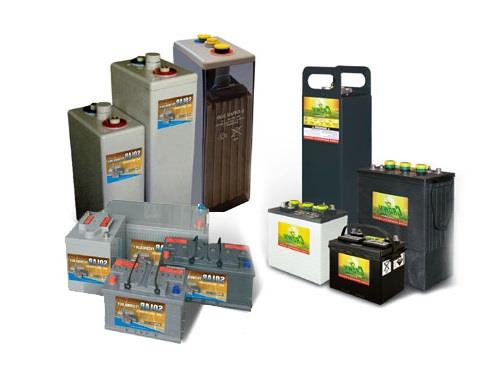Solar batteries form an integral part of off-grid solar energy systems because they help you use solar power during the times when the solar panels couldn’t produce enough. This could be the absence of the sun during cloudy days and foggy days. Even in grid-connected systems, batteries can help during power outages. There’s actually more that the batteries can help with for your solar power needs.
In this article we explore the plethora of solar batteries and highlight their advantages as well as introducing the best products in their categories. In a nutshell, we will discuss lead-acid batteries, lithium ion, nickel cadmium and flow batteries. We then wrap up the article with a helpful buyer’s guide.
Types of Batteries For Solar Systems
As promised, here’s a breakdown of the common solar batteries frequently used in off-grid solar power systems to store solar energy for later use.
1. Lead acid batteries
Until recently, lead-acid batteries were solely the mainstay of solar storage systems. There are flooded lead-acid batteries, sealed lead-acid batteries which refer to Gel and AGM. Lead acid batteries are the oldest models for off-the-grid systems and cheaper than Lithium Ion Batteries. The main perks of deep cycle lead-acid batteries have been the low cost of installation, their safety and proven reliability for many years.
However, they tend to be bulky and corrode fast. Again, they require regular maintenance compared to modern technologies in our midst. If you are looking for budget-friendly solar batteries and do not have a problem monitoring and maintaining them, then flooded lead-acid batteries could be your best choice.
Lead-acid batteries have since advanced into AGM (Absorbed Glass Mat) and Gel technologies. AGM batteries have a better efficiency and require less maintenance but are more expensive than the flooded models. Gel, also, are quite expensive but have a low charging voltage and breaks easily.
[content_band bg_color=”#f5f5f5″ border=”all” inner_container=”true”][custom_headline style=”margin-top: 0;” level=”h4″ looks_like=”h4″]Uses of Lead Acid Batteries[/custom_headline]There are two applications of lead acid batteries:
1. SLI – Starting, Lighting, Ignition: Designed to provide high power at once.
Commonly used in cars and motorcycles.
2. DC- Deep Cycle: Could be drained of most of its power and recharged repeatedly.
Commonly used in Solar-powered systems, Wind-powered systems, Traffic lights, Golf carts
and UPS’s(Uninterrupted power supply). [/content_band]
Most Popular Lead Acid Batteries Used For Solar-Powered Systems
All in all, lead-acid batteries cost less than their lithium counterpart batteries. We have chosen some specific models below which can be useful for your solar power storage.
i. Renogy deep-cycle pure gel battery
Renogy is not a new name in the industry. The company is renowned for its flagship of high-performing batteries. Renogy deep-cycle gel battery is a living testimony to a great performance of these batteries. It is a valve regulated lead-acid (VLRA) using a special gel electrolyte.
The main advantage of the battery is lack of maintenance on a regular basis as is the case with flooded lead-acid batteries. Again, it has a long cycle life.
The battery is a 12 volt with a current rating of 200Ah. It is durable due to its heavy-duty lead calcium grids, which guarantee mild corrosion and enables long lifetime of 10 years. Also, it performs well under the conditions of optimal float charge and the operating temperature of less than 25°C.
Moreover, the battery has a low-self discharge due to the presence of lead calcium grids. Thus, per month, the battery is self-discharged by 3% of the battery capacity in room temperature. Unlike the bulky flooded models, this battery is lightweight with just 132 pounds. And judging from positive rating of 4.9 on Amazon, you would be convinced it is a great battery.
ii. NPP deep-cycle AGM battery
NPP deep-cycle AGM battery features the AGM (Absorbent Glass Mat) technology. The technology involves an ultra-thin fine fiber-glass that absorbs the sulfuric acid. The battery is, as a result, spill proof and needs no maintenance.
Another advantage of the technology is that it produces high currents due to its low internal resistance and the battery has relatively a long lifetime. The NPP deep-cycle AGM battery is a 12 volt battery with current rating of 150 amps. It is also lightweight than the aforementioned gel battery.
2. Lithium Ion Batteries
Lithium ion batteries are available in different chemistries. The main model used for solar systems is the lithium ion phosphate (LiFePO4). It is touted as the newest revolution in rechargeable home battery systems. The advantage with these batteries is their lightweight, efficiency and high capacity. Also, they are more durable than the lead-acid batteries. However, they are relatively expensive. Their life cycle can range between 3000 to 5000 cycles. We have a few examples below:
Most Popular Lithium Ion Batteries Used For Solar-Powered Systems
i. Tesla Powerwall
 Tesla Powerwall is one of the latest lithium ion battery technologies. It is a self-powered battery which will perform well in off-grid applications. The battery has a capacity of 13.5 kWh with an efficiency of 90%. The continuous power is rated at 5 kW and the peak power at 7 kW.
Tesla Powerwall is one of the latest lithium ion battery technologies. It is a self-powered battery which will perform well in off-grid applications. The battery has a capacity of 13.5 kWh with an efficiency of 90%. The continuous power is rated at 5 kW and the peak power at 7 kW.
In case you need more power, the battery units can be expanded up to 10 units. For the battery to perform well, its ambient temperature should range between -20°C up to 50°C. The battery’s weight is a bit bulky compared to the latest lead-acid batteries, but lighter compared to the flooded models. The manufacturer is offering 10 years of warranty for this battery which we found satisfactory.
ii. RELiON (Lithium Life) batteries
RELiON (Lithium Life) batteries are lithium iron phosphate (LiFePO4), which supply more usable capacity, but with lighter weight and maintenance free. A RELiON battery has 12 volts and current rating of 100 amps. It performs well with a better capacity than most of lead-acid batteries.
To enhance its safety, the battery features the BMS (Battery Management Systems). Self-discharge is minimal, and it charges fast with an estimated turnaround time of 1 to 3 hours to charge fully. Weighing just 30 pounds, the battery is lightweight compared to all the above-reviewed models.
iii. Renogy (Lithium LiFe)
Renogy (Lithium LiFe) is the latest revolution in rechargeable home battery systems and it can be utilized in RV, solar, marine and off-grid application. The battery has a current rating of 100Ah and voltage rating of 12 volts. It is a lightweight lithium battery with longer life cycles.
[clear]
3. Flow batteries
These batteries are the latest technological advances in solar energy systems. They are characterized by low prices compared to lithium ion batteries. Also, they are cost-effective energy storage batteries.

The flow batteries are durable and you do not have to maintain them regularly. The energy is stored chemically within a liquid electrolyte contained in two tanks. The membrane does not degrade rapidly over time so there is no need to maintain.
4. Nickel Cadmium
 These batteries are also the latest technologies in solar systems. But, they are expensive and it is not easy to dispose of the batteries at the end of their life due to the hazardous nature of the cadmium. As thus, we do no encourage homeowners to purchase these batteries unless you have a plan to dispose the batteries after use.
These batteries are also the latest technologies in solar systems. But, they are expensive and it is not easy to dispose of the batteries at the end of their life due to the hazardous nature of the cadmium. As thus, we do no encourage homeowners to purchase these batteries unless you have a plan to dispose the batteries after use.
How does solar battery storage work?
Solar battery storage works by storing the power from solar panels for later use. Solar panels produce DC energy, so the battery stores it to later use it as AC energy for household appliances. Some batteries have inverters which provide a built-in energy conversion without needing an external inverter. The storage power of the batteries depends on their capacities. The higher the capacity is the more power is going to be stored.
How does a solar battery charge?
The solar battery receives the DC current produced from the solar panels. So, the voltage of the solar panels should be little higher than the voltage of the solar battery. So that, the DC current passes from solar panels to the solar battery; and charge it.
How much does a solar battery cost?
- The price of lead acid batteries varies from 1.6$/Ah to 4.5$/Ah.
- Lithium-ion battery price is from 6$/Ah to 9.6$/Ah.
- Flow batteries, their average price is 650$/kWh; and this is the least price compared to the other battery types.
- Nickel cadmium battery price is from 10$ to 50$.
Warranty period of solar batteries
Warranty of solar batteries varies from one brand to the other. For example, NPP deep-cycle AGM battery has warranty period of two years while Tesla Powerwall has a warranty of 10 years. Meanwhile the RELiON (Lithium Life) battery has the warranty of five years.
Wrap up!
The importance of solar systems relies on the quality of the solar batteries chosen. While there may be hundreds of types on the market, the main types we reviewed here are the most popular. Assess the battery before making any purchase.


Comments
I have heard some great experience about Relion as a cheap alternative battery to Tesla powerwall.
Too bad it’s out of stock on Amazon.?